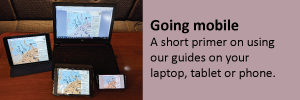Transiting Seymour Narrows
 When our neighbour Matt at Fisherman’s Wharf posted a video on Facebook last week about the detonation of Ripple Rock almost 60 years ago, we began looking at other videos of the blast that made Seymour Narrows less treacherous.
When our neighbour Matt at Fisherman’s Wharf posted a video on Facebook last week about the detonation of Ripple Rock almost 60 years ago, we began looking at other videos of the blast that made Seymour Narrows less treacherous.
The one we posted above does a nice job of telling the whole story. But there are quite a few in the archives of the CBC and others. At the time, on Apr 5, 1958, it was the largest man-made non-nuclear explosion in history.
Turbulent Seymour Narrows, which had claimed some 114 lives, was tamed when the twin underwater peaks of Ripple Rock were trimmed by the explosion.

Travelling north in Discovery Passage from Seymour Narrows. (Photo by Hank Geerlof)
But the current at times of high flow can still run fast, up to 16 knots with eddies and standing waves. If recreational boaters now do not get a little knot in the pit of their stomach when planning a transit of Seymour Narrows, they should.
Happily, transiting at dead slack, or just before or just after the turn so the flow is going with you, is quite safe. Going through at any other time is hazardous for small craft. There are lots of stories about small vessels going through at high flows, but if you lack local knowledge or have innocents aboard, don’t.

Chartlet from Salish Sea Pilot’s Cruising Guide to Desolation Sound. Not to be used for navigation.
If heading north, from marinas at Campbell River or from anchorages at Gowlland Harbour, April Point and Quathiaski Cove, time your departure to travel the 4-6 nautical miles to Seymour Narrows so arrival is at near slack. Be sure to take into account the current in Discovery Passage when calculating your arrival.
Boats which arrive late can await the next turn, or overnight, anchored in the northwest of Menzies Bay.

Brown Bay Marina is tucked into the western shore of Discovery Passage, about two nautical miles north of Seymour Narrows. (Photo by kopwill)
Travelling south, from anchorages in Kanish Bay or Okisollo Channel and around, it is quite simple to time your arrival for slack in Seymour Narrows. Late arrivals can anchor in Deepwater Bay or Plumper Bay, as well as seek a berth at the quite pleasant Brown Bay Marina about two miles north of the narrows.
Discovery Passage, north or south of the narrows, and the excellent anchorages nearby offer lovely cruising. Transiting the narrows can be a bit of a worry, but hurrying through to get it out of the way, can be a wasted opportunity.
(Seymour Narrows, as well as anchorages and marinas off Discovery Passage, is covered in Salish Sea Pilot’s Cruising Guide to Desolation Sound.)



















Wut time is best to pass Seymour narrows Saturday may 14. 2022
At slack. Time your arrival to take into account the ebb or flood before the turn.
It’s hight tide dose the current flow north after hight tide?